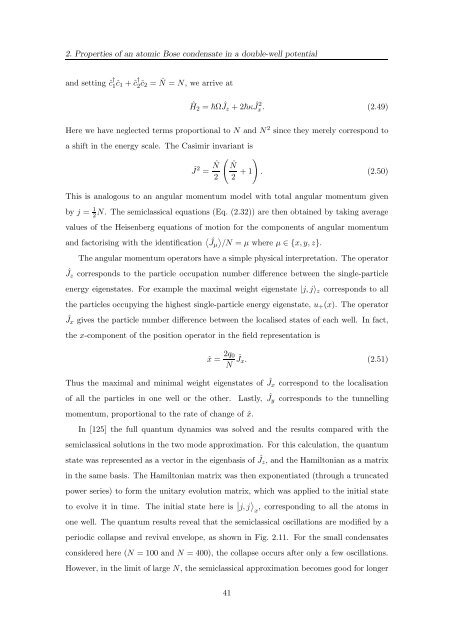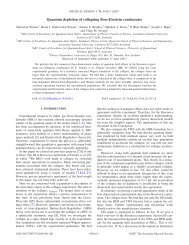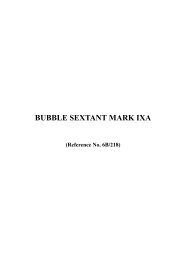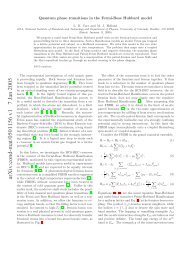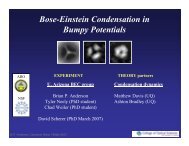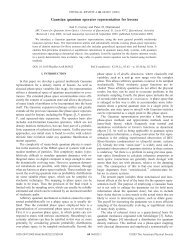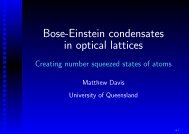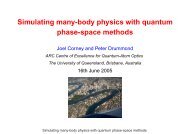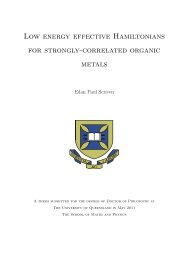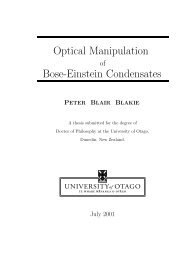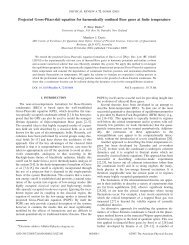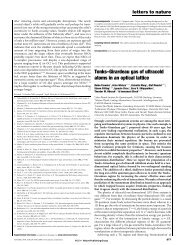Open Quantum Dynamics of Mesoscopic Bose-Einstein ... - Physics
Open Quantum Dynamics of Mesoscopic Bose-Einstein ... - Physics
Open Quantum Dynamics of Mesoscopic Bose-Einstein ... - Physics
You also want an ePaper? Increase the reach of your titles
YUMPU automatically turns print PDFs into web optimized ePapers that Google loves.
2. Properties <strong>of</strong> an atomic <strong>Bose</strong> condensate in a double-well potentialand setting ĉ † 1ĉ1 +ĉ † 2ĉ2 = ˆN = N, we arrive atĤ 2 = ΩĴz +2κĴ 2 x . (2.49)Here we have neglected terms proportional to N and N 2 since they merely correspond toa shift in the energy scale. The Casimir invariant isĴ 2 = ˆN2( ˆN2 +1 ). (2.50)This is analogous to an angular momentum model with total angular momentum givenby j = 1 2N. The semiclassical equations (Eq. (2.32)) are then obtained by taking averagevalues <strong>of</strong> the Heisenberg equations <strong>of</strong> motion for the components <strong>of</strong> angular momentumand factorising with the identification 〈 Ĵ µ〉/N = µ where µ ∈{x, y, z}.The angular momentum operators have a simple physical interpretation. The operatorĴ z corresponds to the particle occupation number difference between the single-particleenergy eigenstates. For example the maximal weight eigenstate |j, j〉 z corresponds to allthe particles occupying the highest single-particle energy eigenstate, u + (x). The operatorĴ x gives the particle number difference between the localised states <strong>of</strong> each well. In fact,the x-component <strong>of</strong> the position operator in the field representation isˆx = 2q 0N Ĵx. (2.51)Thus the maximal and minimal weight eigenstates <strong>of</strong> Ĵ x correspond to the localisation<strong>of</strong> all the particles in one well or the other. Lastly, Ĵ y corresponds to the tunnellingmomentum, proportional to the rate <strong>of</strong> change <strong>of</strong> ˆx.In [125] the full quantum dynamics was solved and the results compared with thesemiclassical solutions in the two mode approximation. For this calculation, the quantumstate was represented as a vector in the eigenbasis <strong>of</strong> Ĵz, and the Hamiltonian as a matrixin the same basis. The Hamiltonian matrix was then exponentiated (through a truncatedpower series) to form the unitary evolution matrix, which was applied to the initial stateto evolve it in time. The initial state here is ∣ j, j , corresponding to all the atoms in〉xone well. The quantum results reveal that the semiclassical oscillations are modified by aperiodic collapse and revival envelope, as shown in Fig. 2.11. For the small condensatesconsidered here (N = 100 and N = 400), the collapse occurs after only a few oscillations.However, in the limit <strong>of</strong> large N, the semiclassical approximation becomes good for longer41


